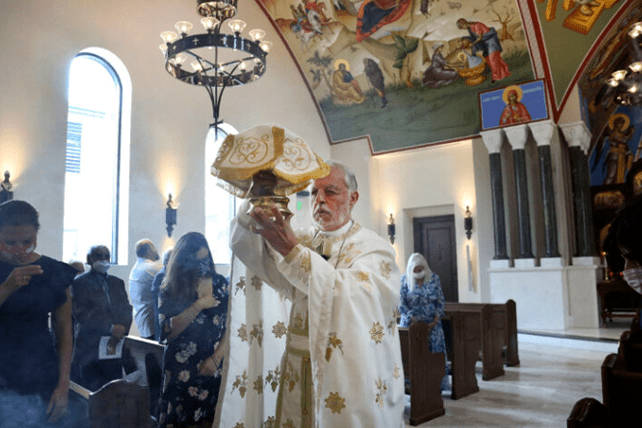During that double crisis, in which hundreds of local homes burned to the ground, people began showing up to St. Seraphim.
“They started thinking more about eternal realities, I guess, and their life in this world,” said Margitich.
According to several Orthodox clergy who have spoken to RNS, the pandemic lockdowns provided more time at home to browse the Internet and self-reflect, leading many spiritual seekers to come across Orthodoxy for the first time across a proliferation of English-language resources online and then visit a local church.
This year, St. Seraphim of Sarov Cathedral has experienced more baptisms than ever before in Margitich’s 27-year career, he said, with 20 people catechized in the spring and 20 more in the process of conversion.
An earlier report by Krindatch concluded that while most Orthodox churches in the U.S. shrank an average of 15% in regular attendees from 2020 to 2022, 1 in 5 parishes instead grew their membership and in-person attendance by 20%. The growing parishes tend to be those that not only remained open for in-person worship during the pandemic, but also didn’t offer online worship, have a higher percentage of converts and have greater unity of opinions, among other factors.
By spring 2023, 15% of the members of a median Orthodox parish were newcomers who had joined since the start of the pandemic in 2020, compared to only 10% among other U.S. religious congregations, the latest study showed.
“It is a statistically significant difference,” Krindatch said. “But there are bigger differences between Orthodox jurisdictions. People were definitely looking for any place they could join.”
The Russian Orthodox Church Outside Russia, commonly called ROCOR and considered the most conservative jurisdiction, picked up significantly more members than the Orthodox Church of America, which in turn picked up more than the Greek Orthodox Archdiocese, according to Krindatch’s data.
The Rev. Luke Veronis of Sts. Constantine and Helen Greek Orthodox Church in Webster, Massachusetts, near the Connecticut border, called the pandemic a “positive” experience for his parish, despite describing his congregation as “extremely divided” politically, with both progressives and Donald Trump loyalists, who he refers to as “a family.” The COVID-19 restrictions pushed the church to livestream services and meet on Zoom, alternatives they have continued to offer for liturgies and Bible studies alongside the in-person gatherings.
Veronis’ church also experienced atypical growth, from 150 regular monthly attendees in 2019 to about 220 today, he said. Most joined during the pandemic and are young adults under the age of 35. Many of the Greek Orthodox churches in New England are either declining or struggling to remain open, while only a handful are growing.
“The key to our success is we’ve created a very welcoming church,” said Veronis, who also teaches a class about cultivating “missions-minded” parishes at Hellenic College and Holy Cross Orthodox School of Theology in Brookline, Massachusetts. “I always preach to my people, our church welcomes everybody … but then, of course, the challenge for everybody is once you come into the church, we all are on a journey of change and transformation. So don’t come with your agendas.”

